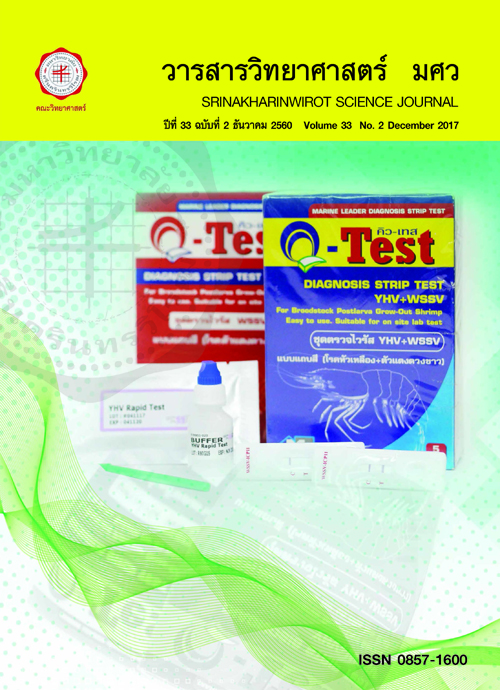การฟื้นฟูดินปนเปื้อนร่วมกันระหว่างสารประกอบปิโตรเลียมไฮโดรคาร์บอน และโลหะหนักด้วยพืชภายใต้ภาวะความเค็ม
Keywords:
Phytoremediation, Co-contaminated soil, SalinityAbstract
บทคัดย่อการฟื้นฟูดินปนเปื้อนร่วมกันระหว่างโลหะหนักและสารประกอบปิโตรเลียมไฮโดรคาร์บอนภายใต้ภาวะความเค็มเป็นสิ่งจำเป็นต่อการดูแลรักษาและพัฒนาระบบนิเวศดินให้ยั่งยืน ในปัจจุบันการฟื้นฟูด้วยพืชซึ่งเป็นเทคนิคที่สะอาดและมีความปลอดภัยต่อสิ่งแวดล้อมได้ถูกนำมาใช้สำหรับแก้ไขปัญหาการปนเปื้อนร่วมกันของสารมลพิษ โดยพืชที่ใช้ฟื้นฟูสภาพดินปนเปื้อนภายใต้ภาวะความเค็มนั้นจะต้องมีคุณสมบัติที่สำคัญในการทนต่อความเค็มและมีความสามารถในการกำจัดสารปนเปื้อนได้ดี แม้ว่าพืชฮาโลไฟต์จะมีความเหมาะสมที่สุดสำหรับกระบวนการฟื้นฟูดินปนเปื้อน แต่การใช้พืชฮาโลไฟต์บางชนิดก็มีข้อจำกัดอยู่พอสมควร ความสามารถในการกำจัดการปนเปื้อนร่วมกันของสารมลพิษก็เป็นปัจจัยจำกัดที่มีผลต่อประสิทธิภาพสำหรับกระบวนการฟื้นฟูด้วยพืชอีกด้วย ทั้งจากพิษของโลหะหนักต่อประสิทธิภาพการย่อยสลายทางชีวภาพของสารประกอบปิโตรเลียมไฮโดรคาร์บอนและความเป็นพิษของสารประกอบปิโตรเลียมไฮโดรคาร์บอนต่อปริมาณการสะสมโลหะหนักในพืช ยิ่งไปกว่านั้นความเค็มของดินก็เป็นสาเหตุให้มีการสะสมโพรลีนเพิ่มมากขึ้น ขณะที่การเติบโตและปริมาณคลอโรฟิลล์ของพืชลดลง ซึ่งความเค็มยังมีบทบาทที่สำคัญต่อการย่อยสลายสารประกอบปิโตรเลียมไฮโดรคาร์บอนโดยจุลินทรีย์และการเคลื่อนที่ของโลหะต่อพืช ดังนั้นการคัดเลือกชนิดพันธุ์พืชที่มีประสิทธิภาพในการกำจัดสารปนเปื้อนร่วมกันระหว่างโลหะหนักและปิโตรเลียมไฮโดรคาร์บอนนั้นถือว่าเป็นสิ่งที่จำเป็น - - -Phytoremediation of Heavy Metal and Total Petroleum Hydrocarbon Co-contaminated Soil under Salinity Condition ABSTRACTRemediation of heavy metal and petroleum hydrocarbons co-contaminated soil under salinity is essential to sustainable development and maintenance of soil ecosystems. Recently, an environmentally safe and clean technique known as phytoremediation has been introduced to address the co-contamination problem. Plant properties important for phytoremediation of contaminated soil under salinity condition are ability to tolerate soil and remove contaminants. Although halophytes are appropriate for phytoremediation of contaminated soil, the application of some halophytes is rather limited. Co-contamination of these pollutants limits the efficiency of phytoremediation both from heavy metal toxicity to potential biodegradation of total petroleum hydrocarbons (TPHs) and TPHs toxicity to heavy metal accumulation in plants. Moreover, the presence of salt caused a marked reduction in plant production, the total chlorophyll content in plant tissues, and high accumulation of proline. Salinity plays an important role in the degradation of TPHs by microorganisms and metal mobility to plants. Therefore, heavy metal and TPHs removal by vegetation can be greatly enhanced by the judicious selection of plant species.Downloads
Download data is not yet available.
Downloads
Published
2017-08-04
How to Cite
จำปาศรี ก., & แสงงาม ส. (2017). การฟื้นฟูดินปนเปื้อนร่วมกันระหว่างสารประกอบปิโตรเลียมไฮโดรคาร์บอน และโลหะหนักด้วยพืชภายใต้ภาวะความเค็ม. Science Essence Journal, 33(2), 229–246. Retrieved from https://ejournals.swu.ac.th/index.php/sej/article/view/8272
Issue
Section
บทความวิชาการ








